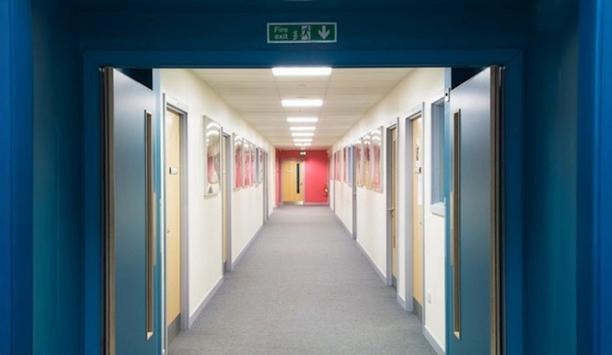In its most recent five-year report on structure fires in U.S. schools, the National Fire Protection Association (NFPA) found that from 2013-2017, school fires resulted in a total of 212 injuries – a 32 percent drop from the previous five year period. These are remarkable numbers when one considers that during that time, there were more than 16,500 school fires reported.
On average, school fires cause $42 million in direct property damage each year. While the schools are clearly doing an excellent job at keeping children safe from fire, the communities they serve face a significant financial burden when a fire occurs.
Providing key insights
This post will provide some of the key insights gleaned from the NFPA report to help people better understand the causes of fires in schools. For context, it may be helpful to know just how many schools they have here in the U.S. According to the most recent data from the National Center for Education Statistics; there are 133,390 K-12 schools in the United States, which include:
- 87,498 elementary schools (kindergarten through fifth grade)
- 26,727 secondary schools (grades 6-12)
- 15,804 schools in which all grades are combined
The NFPA report found that from 2003-2017, most fires occurred at middle, junior and high schools (42 percent), followed by elementary schools (38 percent); preschools and daycares (12 percent); and other, non-adult schools (8 percent).
Top causes of school fires
The figure below illustrates that there were some differences between elementary schools and secondary schools
The cause of school fires were intentional fires. The other top causes of school fires were kitchen fires, children playing with heat sources such as matches and lighters, and fires caused by heating equipment malfunctions. Fires caused by careless smoking was also a factor in some middle and high school fires but not in elementary school fires.
The figure below illustrates that there were some differences between elementary schools and secondary schools (middle and high schools) in terms of the percentage of fires associated with each cause. However, the top four causes were the same across both age groups.
Common sources of ignition
Fires set intentionally account for more than 40 percent of all school fires and cause almost one-third of the direct property damage resulting from school fires each year. A U.S. Fire Administration report, ‘School Building Fires (2009-2011),’ lends some insight into some of the reasons young people intentionally start fires at school.
According to the report, young people involved in fire setting generally fall into four groups, which are often not mutually exclusive:
- Curiosity – Fires set by younger children are often the result of curiosity about common sources of ignition, such as matches or lighters. These fires usually start with a lack of supervision of children who do not understand the danger associated with their actions.
- Crisis – Some fires are started by children in crisis who do not have adequate problem-solving skills or cannot express their emotions. A lack of supervision and easy access to sources of ignition can sometimes lead these children to resort to fire setting to convey their feelings.
- Delinquent – This group is typically comprised of older adolescents who tend to be antisocial and set fires on purpose with the specific intent of causing destruction. These kids are sometimes driven by peer pressure or a desire to show off. However, they often do not understand the legal repercussions associated with setting fires.
- Pathological – This group is typically comprised of teenagers, often those with mental disorders, few social skills, and few, if any, personal relationships with their peers. With this group, fire setting is often a coping mechanism.
Portable fire extinguishers
The report recommends that schools immediately report all fires to the local fire service, even small fires that were extinguished quickly. The fire service can assist with identifying the ignition source and whether they were intentionally set. This can help to identify children who may be using fire in inappropriate and unsafe ways so that the appropriate intervention strategies can be implemented.
The report found that fires ignited by cooking materials were generally minor fires
Fires caused by cooking equipment were the second cause of school fires but resulted in far less property damage than fires resulting from other causes. The ongoing presence of kitchen and other staff in schools is likely to be a factor that differentiates cooking-related fires in schools from those in homes where cooking fires may be unattended and more likely to cause damage.
The report found that fires ignited by cooking materials were generally minor fires. This fact underscores the importance of ensuring that school kitchens are equipped with hood suppression systems and portable fire extinguishers and that both are properly inspected and maintained.
Portable space heaters
Playing with lighters and matches accounts for a significant number of school fires both in elementary schools as well as middle and high schools. Not surprisingly, the number of injuries resulting from these fires is much higher in the elementary schools, where children are much less likely to understand the potential risks or what to do to protect themselves when they inadvertently start a fire.
Playing with a heat source accounted for 29 percent of the injuries resulting in elementary schools, while in middle and high schools, 19 percent of all injuries were due to fires resulting from these behaviors. Heating equipment accounts for one in 10 school fires every year. These fires started in confined fuel burners or boilers, fixed and portable space heaters, central heating systems, water heaters, and other types of heating equipment.
Maintaining safety and security
In comparison to the other causes of fires in schools, these fires cause their fair share of direct property damage
While fires resulting from portable space heaters can be prevented with more attention to their placement and use, most other fires caused by heating equipment potentially suggest gaps in maintenance and repair of school equipment or infrastructure.
In comparison to the other causes of fires in schools, these fires cause their fair share of direct property damage. At an average of $2 million per year, the NFPA report serves as a sobering reminder that when it comes to fire, an ounce of prevention can go a long way to keeping both students and schools safe.
One can count on Koorsen to keep them informed when new reports are published with insights and information that one can use to help keep the schools safe from fire and security risks. Their Fire and Security team knows the unique challenges of maintaining safety and security in an educational facility and offers total protection from one source.















